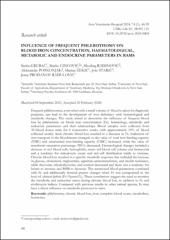Influence of Frequent Phlebothomy on Blood Iron Concentration, Haematological, Metabolic and Endocrine Parameters in Rams

View/
Date
2024Author
Grubač, Siniša
Cincović, Marko
Radinović, Miodrag
Potkonjak, Aleksandar
Žekić, Marina
Starič, Jože
Prodanov-Radulović, Jasna
Metadata
Show full item recordAbstract
Frequent phlebotomies, even when only a small volume of blood is taken for diagnostic
purposes, can lead to the development of iron deficiency with hematological and
metabolic changes. The study aimed to determine the influence of frequent blood
loss by phlebotomy on blood iron concentration (Fe), hematology, metabolic and
endocrine parameters and their relationships. Blood samples were collected from
30 blood donor rams for 6 consecutive weeks, with approximately 10% of blood
collected weekly. Such chronic blood loss resulted in a decrease in Fe. Indicators of
iron transport in the bloodstream changed, so the value of total iron-binding capacity
(TIBC) and unsaturated iron-binding capacity (UIBC) increased, while the value of
transferrin saturation percentage (TS%) decreased. Hematological changes included a
decrease in red blood cells, hemoglobin, mean red blood cell volume and hematocrit
and a tendency for reticulocyte count and red cell distribution width to increase.
Chronic blood loss resulted in a specific metabolic response that included the increase
in glucose, cholesterol, triglycerides, aspartate-aminotransferase, and insulin resistance,
while thyroxine, triiodothyronine and cortisol decreased and there was a tendency for
lactate to increase and BHB to decrease. The mentioned blood parameters correlated
with Fe and additionally showed greater changes when Fe was extrapolated to the
level of clinical deficit (Fe=9μmol/L). These correlations suggest the need to monitor
the metabolic and endocrine status during chronic blood loss, in addition to Fe and
erythrocyte indices. Compared with previous results in other animal species, Fe may
have a direct influence on metabolic processes in rams.
